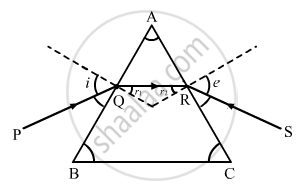Advertisements
Advertisements
प्रश्न
A ray of light passes through an equilateral glass prism such that the angle of incidence is equal to the angle of emergence and each of these angles is equal to 3/4 of angle of prism. Find the angle of deviation.
उत्तर
The angle of deviation δ for a ray of light in a prism is given by
δ=i+e−A
where
i = Angle of incidence of ray
e = Its angle of emergence
A = Angle of prism
`∵e=i`
` ⇒δ=2i−A`
Given:` i=e=3/4A`
`∴δ=2×3/4A−A`
`⇒δ=1/2A`
As the prism is equailateral,⇒A=60°
`∴δ=12×60°`
`⇒δ=30`
APPEARS IN
संबंधित प्रश्न
Figure shows a ray of light passing through a prism. If the refracted ray QR is parallel to the base BC, show that (i) r1 = r2 = A/2 and (ii) angle of minimum deviation, Dm = 2i − A.

If three identical prisms are combined, is it possible to pass a beam that emerges undeviated? Undispersed?
The angular dispersion produced by a prism ___________ .
A thin prism of angle 6.0°, ω = 0.07 and μy = 1.50 is combined with another thin prism having ω = 0.08 and μy = 1.60. The combination produces no deviation in the mean ray. (a) Find the angle of the second prism. (b) Find the net angular dispersion produced by the combination when a beam of white light passes through it. (c) If the prisms are similarly directed, what will be the deviation in the mean ray? (d) Find the angular dispersion in the situation described in (c).
In a regular prism, what is the relation between angle of incidence and angle of emergence when it is in the minimum deviation position?
Calculate dispersive power of a transparent material given : nv = 1.56, nr = 1.54, ny = 1.55.
What is meant by the dispersive power of transparent material?
Define angular dispersion.
Prove that in case of a prism, i + e = A + δ, where the symbols have their usual meanings.
What is meant by a thin prism?
